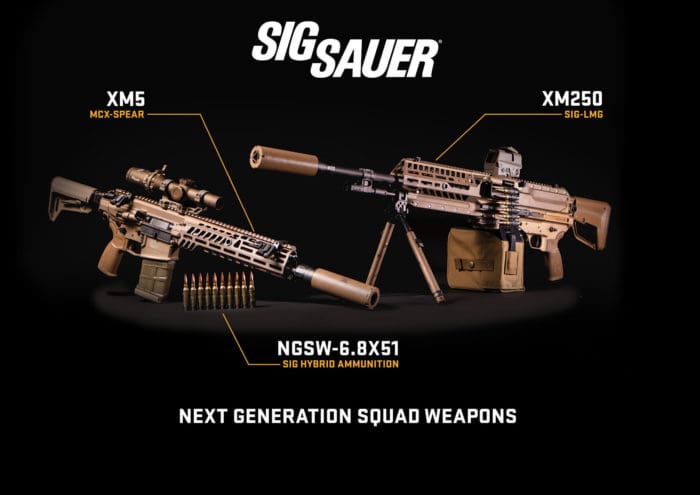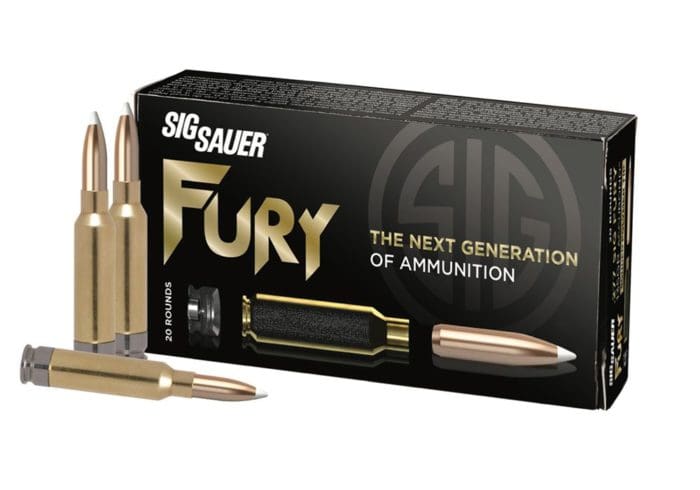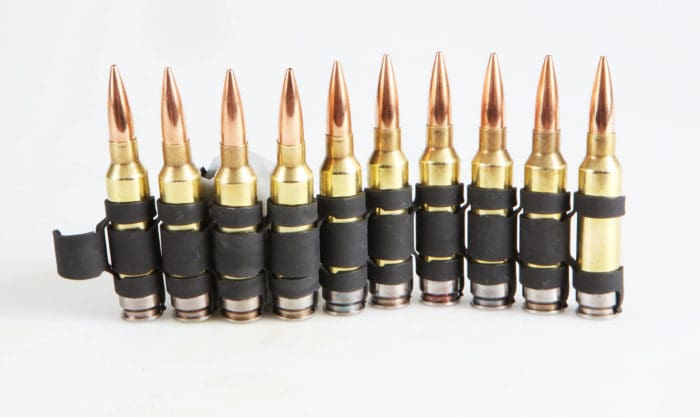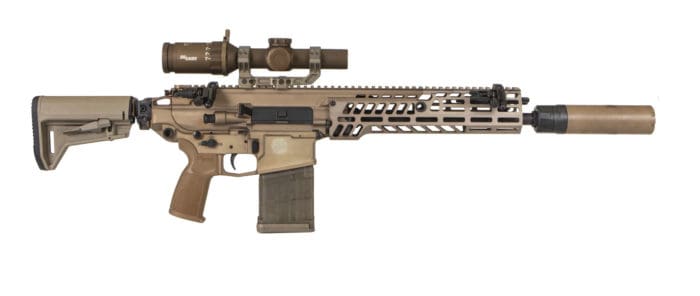Like any huge government bureaucracy, the U.S. military tends to be slow to change. They kept the same pistol from 1911 until 1985. They’ve basically been running variants of the M16 in most roles since the Vietnam war. So when we say that the Army’s choice of a new squad rifle is a “once in a lifetime” piece of news, that isn’t much of an exaggeration.
Yesterday they announced the culmination of a years-long process with the adoption of the new MCX-SPEAR XM5 rifle (which will replace the M4 over time) and SIG-LMG M250 machine gun (replacing the M249 SAW).
SIG’s entries the Next Generation Squad Weapon (NGSW) competition are based on the SIG MCX rifle, and use 6.8x51mm hybrid ammunition (.277 FURY). SIG will also make SIG SLX suppressors for the rifles. The value of the contract has been estimated as high as $6.5 billion.
If you want in-depth information, I’d recommend watching the Army’s press conference announcing the awarding of the contract . . .
The XM5 Rifle
While the MCX looks like an AR-15 variant, that’s only kind of true. The MCX and its variants have been around since the 2015 SHOT Show, but its short-stroke piston gas system (a departure from the AR’s direct impingement gas system) came from the MPX submachine gun.

Innovative features of the XM5 include barrel tapering at the crown to make it easier to use accessories, like a suppressor, without having to use performance-reducing washers. This design also allows barrel devices to self-center. Barrel changes can happen in seconds, allowing the military to quickly change calibers, barrel lengths, or to make other desired changes with minimal work. It’s also possible to install the 5.56mm MCX upper on a standard AR lower with an adapter.
The new guns are chambered in .277 Fury, with is too-long-to-fit-in-an-AR-15 magazine, which means it has to have a larger magazine well like an AR-10. The good news? That means it will be able to accept rounds like .308 Winchester (7.62×51 NATO) or 6.5 Creedmor with nothing but a barrel change, but you’ll probably only want to do that if you can’t find any 6.8x51mm ammo.

The new rifles will be fielded to units with the new XM157 Next Generation Squad Weapons-Fire Control (NGSW-FC) systems from Vortex. It uses a laser rangefinder, ballistic calculator, atmospheric sensors, orientation sensors, a compass, and even communication with other soldiers’ optics to calculate shots. This system can (and will) also be reprogrammed to work with other platforms, including the M4 and 7.62mm-based weapons.
This active reticle optic will be able to link to radical new technologies like the Integrated Visual Augmentation System (IVAS), which will allow soldiers to “shoot around corners” and even “see” through barriers if the system is receiving data from other sources that have line-of-sight capability.
The 6.8×51 Hybrid Round
What makes the XM5 and its XM250 machine gun variant really special is its ammunition. Metallurgy has come a long way since the Vietnam war, and so has the technology of making bullets, cases, and powders.

What SIG accomplished in the the new hybrid round is to pack magnum power into a .308-sized package (and 20+ of the cartridges fit in normal AR-10 magazines). The 6.8x51mm, or .277 SIG Fury, uses a special hybrid case, with the front of the case made from easily-fed and ejected brass and the rear of the case made of much tougher steel to survive the 80,000 psi of pressure the cartridge generates. The result? 135-grain bullets zipping along at 3,000 feet per second, and from a 16″ test barrel. That’s spicy.

This gives the round a decisive advantage over 5.56mm NATO rounds (and .223 Remington) and just about anything else other militaries are fielding in great numbers. In many ways, this means the Army is heading away from assault weapons (that use intermediate cartridges) and back into battle rifle territory…but with more power than the .308/7.62×51 had in guns like the M14.
Who and When?
The rifles will only be for what the Army defines as close combat forces, or forces within line of sight with the enemy, at least at first. Specifically, one general said this is 11B infantry, 19D cavalry scouts, 12B combat engineers, 68W medics, and 13F forward observers. Everyone else will continue to use existing weapons systems, including M4s with 5.56 NATO and other weapons with 7.62×51 NATO rounds unless and until the Army decides to switch everyone to 6.8x51mm in the future.
Other armed services (the Marines were named specifically) were involved in the selection and testing process, and have expressed interest, but the decision to equip other branches with the new weapons and caliber remains with those other services.
Army units doing close combat as defined above will receive the new weapons as ammunition stores become available for training and combat. In other words, they don’t want to issue guns to any unit unless there’s enough ammunition to train on the new weapons and go right into a major war from day one.

Some units will get weapons and ammo in 2023 and 2024 using ammunition provided by Sig directly, but full ammunition production at a new building at the Lake City ammunition plant will not happen until 2025-26. Sig will continue to produce ammunition as a second source going forward after that.
Here’s SIG’s full press release announcing the Army’s decision . . .
SIG SAUER is honored to be awarded the Next Generation Squad Weapons System (NGSW) Contract by the U.S. Army after a rigorous 27-month testing and evaluation process.
“The U.S. Army is taking a bold step toward command of the 21st century battlefield and SIG SAUER is immensely proud to be the selected provider for this historic revolution in infantry weapons. The fielding of the SIG SAUER Next Generation Squad Weapons System will forever change the dynamic of military engagement for America’s warfighters with American innovation and manufacturing,” began Ron Cohen, President and CEO SIG SAUER, Inc..
The SIG FURY Hybrid Ammunition (6.8 Common Cartridge), SIG-LMG (XM250), SIG MCX-SPEAR Rifle (XM5) and SIG SLX Suppressors meaningfully advance soldier weapons technology to meet the emerging requirements of the U.S. Army.
The SIG 6.8×51 FURY Hybrid Ammunition uses a patented lightweight metallic case designed to handle pressures higher than conventional ammunition, resulting in dramatically increased velocity and on-target energy in lighter weapons.
The SIG-LMG lightweight belt-fed machine gun and SIG MCX-SPEAR Rifle are purpose-built to harness the energy of the SIG FURY 6.8 Common Cartridge Ammunition enabling greater range and increased lethality while reducing the soldier’s load on the battlefield. Both the SIG-LMG and MCX-SPEAR deliver significant weapon and technology advancements to the soldier and provide a solution for battlefield overmatch in comparison to the current M249 and M4/M4A1.
The U.S. Army’s procurement of the NGSW System marks the beginning of an era where combat weapons are coupled with a suppressor as standard issue equipment. The SIG SLX Suppressors are designed to reduce harmful gas backflow, sound signature and flash. SIG SLX Suppressors feature a patented quick detach design for easy install and removal.
“We commend U.S. Army leadership for having the vision to undertake this historic procurement process to deliver a transformational weapon system to our warfighters. This award is the culmination of a successful collaboration between SIG SAUER and the U.S. Army, and we look forward to the continuing partnership,” concluded Cohen.
SIG SAUER is a company that is driven by innovation and we are proud to offer the advancements of the NGSW System in the SIG 277 FURY Hybrid Ammunition (the commercial variant of the SIG 6.8×51 FURY Ammunition round), SIG MCX-SPEAR Rifle, and the SIG SLX Series of Suppressors available to the consumer. For more information about these products visit sigsauer.com.





Thank God the United States has a strong and vibrant “military industrial complex”, that can produce weapons of all types. For both military and civilian use.
I remember we were running low on air delivered bomb options a decade ago and I am guessing we haven’t improved things.
Not all that strong, it’s been said it will take 2-3 yrs. to replace all of the Javelin’s we’ve sent the UA. Fairly worrying when you figure probabilities going up against a near-peer OpFor in the conventional realm who is armor heavy.
Gonna ramp production in the less likely event if they’re on native soil?
Take note, without air superiority or dominance, the majority of AT/AIFV kills have been reliant on boots on ground with ATGM’s, with little evidence the hordes with molotovs have had any tangible successes.
[email protected]
Not all that strong, it’s been said it will take 2-3 yrs. to replace all of the Javelin’s we’ve sent the UA. Fairly worrying when you figure probabilities going up against a near-peer OpFor in the conventional realm who is armor heavy.
Gonna ramp production in the less likely event if they’re on native soil?
Take note, without air superiority or dominance, the majority of AT/AIFV kills have been reliant on boots on ground with ATGM’s, with little evidence the hordes with molotovs have had any tangible successes.
I was rock’n to this song in the Army back in 1986. Atomic weapons kept America and the Ukraine safe. Until the Libertarians Liberals and the Left talked the Ukraine out of keeping their DEFENSIVE Atomic WEAPONS.
With the promise made by the Democat, President Clinton, would protect them.
“Thank God for the Bomb”
by Ozzy Osbourne video 3 min long
change only works when it’s to something better…[and, hopefully domestically produced]…sure is profitable, though…for all concerned….
Going to be issued to the “Close Combat” troops. Well they are using MP7A2 and H&K 416 10″ carbines with suppressors. So you are telling me that carrying these large broomsticks into a building for CQB is going to be a better choice. These Generals need to get off their asses and get some trigger time, not at a square range for an industries demo, but running sweating and getting dirty. Bigger, heavier, more blast, even suppressed and less ammo, sounds like a good deal to me. Brought to you by the same people that spec’s out the Mark 23 “Offensive” Pistols, that were almost as heavy as a short M4 with all the crap they bolted on to them. In real life they lived in the armory and the “Special Troops” went back to the P2266 Mk25 and HK 45 pistols.
They aren’t referring specifically to CQB (or SOF).
I.e. not ADA, pilots, staff, cooks, etc.
The desire for this platform and this round didn’t come from the generals. It came directly from deployed troops, especially SF, and the early development came from inside units, not the big army.
Like Umm said, they spelled out exactly the troops that are getting these, and they will be extremely welcome. Those 10″ 5.56 carbines absolutely sucked. Everyone I deployed with in Afghanistan, including the SF units, preferred the 20″ barreled rifles. Our average intiital engagement distance was 400 meters. That little pill moving slower from it’s 10″ barrel had all the blast and none of the energy required at those distances. If our enemies are armored, that problems going to get a lot worse.
Is the army always fighting the last war?
No, and this weapon system is evidence of that.
I’ve been seeing a bit about this over the last few days. What I find interesting is that the military is looking to go to a battle rifle caliber to do, well, battle. A couple of really good things about this outfit.
First, the caliber’s name sounds cool. Not like a FUDD caliber. Even though it delivers FUDD/battle rifle ballistics. Next, and this is really important, it doesn’t look like a FUDD gun. This weapons system looks cool! An aside, at least the gas system was upgraded to something that sounds like it could be more reliable than other systems. Finally, it comes with a suppressor. I do like suppressors. But, I have no illusions. Everytime I’ve heard a suppressed super-sonic rifle fired I’ve thought, “That sounded like a suppressed rifle.” I just wonder about their real utility on the open battlefield. Every infantry man that has ever been issued a new piece of equipment has asked the eternal question, “Is it worth the weight?”
The suppressor is more about hearing loss and the ability to communicate among each other than hiding from an enemy.
JWT, I know that. But, if I’m not the Devil’s Advocate, then who?
The cartridge looks like a .270 short. 6.8SPC is .270 light.
The story that the MK 23s aren’t used isn’t true. While sharing mine at the range, a former “Special Troop” friend told me about the time a case full of them fell out of their HMMWV in Iraq, and the $#!+ he would have been in if they hadn’t realized it. They aren’t EDC; but their aren’t cage queens either.
During my Army career, much of it as a 19D Cavalry Scout, I was subject to many “new” and “innovative” weapons and systems. Few were welcomed or helped. Many were unbelievably stupid. The XM5 and XM250 seem like a move in the right direction. Looking forward to getting some hands-on time to make a better judgement.
(Disclaimer: not currently serving, so it could be a while).
I read they increased the base rifle 10% over the M4. AND they managed to go with a heavier round?
Gosh, just what grunts have been asking for, more weight.
Seems like a terrible, horrible, idea. I understand wanting to defeat body armor, but they could have gone with something that did the same, but REDUCED weight. I find this a really, really odd choice.
D Y, the base weapon weight of the M5 is 2 pounds heavier than the M4. Of course, that is without the optics and suppressor. So yeah, this is going to be a little more cumbersome. If accuracy and lethality are improved enough, the burden will be worth it.
The round is heavier than the 5.56mm but less than the 7.62mm.
It’s pushing a 135gr .277″ bullet at the same speed from a 16″ barrel as the .308Win pushes a .308″ 135gr bullet from a 24″ barrel.
A 16″ 7lb bolt gun so chambered would be a North American hunter’s dream come true.
No. You can’t get around physics. If you know you need a heavier, more energetic round, then you’re going to get a heavier weapon or an unacceptable level of recoil.
I think SPEAR is idiotic nomenclature for a 21st Century weapon.
The cartridge is too powerful for a sissified woke army, how about .22LR instead ?
They probably looked into 22LR but discovered that the process of loading them into linked belts resulted in unacceptably high instances of undesirable uncontrolled ignition. Barrel life probably proved to be impressive though.
Pb, I haven’t forgotten about you. Mark is back from being made a fool of by large ground dwelling birds in SC. Lisa is supposed to have returned from her horseback trip in the West. Hope to settle this weekend. I need them both to conclude the deal. Aren’t deals fun? You asked to post buying price. I don’t mind, but for a 686 no dash if I leave with it for $800 I’ll be happy. Might go $900. Won’t bust $1000. Well, maybe if it we’re a 6″ instead of a 4″. It could be even more FUDD! Seriously, l want the LC 7.62 NATO. Ammo first. I’ll take the 686. Depending. Let you know.
Thanks!
Meh. The 6.8×51 (aka 277 Fury) pushes a 140 gr bullet at 3000 FPS from a 16″ barrel. The .270 Winchester (designed in the 1930’s no less) pushes a 130 gr bullet at 3000 FPS from a 20″ barrel. In order for the 6.8 to achieve the velocity with 4″ less barrel the designers increased the chamber pressure from 50,000 PSI to more than 80,000 PSI and went to a (expensive) 3-piece cartridge case. I wonder how many guns they are going to blow up?
Sometimes a new mouse trap isn’t a better mouse trap.
One of the options used a bullpup 20 inch barrel with more standard pressure but obviously was not selected. It will be interesting to see how the steel and tungsten cored ammo for this rifle fare against lv 3/SAPI analog and lv 4/ESAPI analog plates. At a guess lv 4 may become the minimum and some companies may need to redo their specs.
Ah yes, the every soldier is now a DMR sniper concept. Because it has only failed, well, every time it was attempted.
The sig 6.8 and .338 machine guns are great ideas. Both lighter and more power than current M249 and M240. Plus suppressors. Or make the current ones take polymer ammo. Both would’ve been a definitive upgrade in terms of weight.
But replacing the M4 with a DMR is the opposite. A Sig MCX in 6arc or 6.8spc would be a manageable power upgrade. Or a Desert Tech style bullpup with polymer ammo, for longer barrels and always suppressed in a short package. This is just another attempt to turn soldiers into 200lbs carrying super combat mules. Can we get 20mm infantry rifles already?
I wish they’d at least somewhat adopt 6.8 SPC so I could find some ammo at a decent price. That’s why it makes sense for civilians to have 5.56 rifles.
I wish they would declare the Mk316 Mod O 7.62 round to be obsolete surplus and start seeing it released to the civilian market… Lord knows a 1200 yard effective loading doesnt have the reach for those really long urban streets that our next conflicts will take place in.
If you are going to have to punch through armored humans at range, the 6ARC or my beloved 6.8SPC just won’t do the trick.
That’s been my guess for the round. Russia may not be fielding body armor in mass but China makes a huge number of plates that even on the lower end compared to most American manufacturers are not terrible.
Was this all in response to the longer engagement distances of Afghanistan?
Since we’re on the doorstep of an urban conflict in eastern Europe, to say nothing of China, is this a move toward the past and not the future?
It’s a move to get to the bank to cash some checks. I’ll go out on a limb and say lobbying was involved.
We always train to fight the last war or a combination of expected wars. We trained to refight Vietnam while planning on stopping the Soviets at the Fulda Gap. We ended up fighting in a desert against a less equipped and motivated military. After DS we trained to fight DS again and ended up in Afghanistan and Iraq under entirely different circumstances we did not plan for.
We had good leaders who wanted more training in counterinsurgency, the civilian leaders felt it was not necessary. We have leaders in both the military and civilian sides who can’t seem to plan for what is on the horizon or are willing to properly fight a war. WWII arguably was the last war we fought to win.
Kind of, but not really.
This was a response to seeing how our current options would fail at those distances if our opponents were lightly armored.
For unarmored opponents at 400 meters, the new 75-77gr OTM 5.56 rounds work just fine, and they very welcome. But once those same folks put on plates or even soft armor, that lethality is extremely diminished.
This is an example of the US preparing for the next war. Only time will tell if we got it right.
Let’s hope we get it right.
For once.
Cool – we’re going with:
– 20% heavier rifle
– More complicated and heavier optic
– 33% less capacity
– 300% more ammunition weight
At least the ammo theoretically defeats all known and forthcoming body armor with better terminal ballistics. A great rifle for the war we just fought (and left). Maybe not the best idea for the most likely upcoming war (dense urban environments with close quarters maneuvering and limited range engagements).
Except that’s not what our next war will likely be, and Ukraine is proving that.
Nobody intends on long fights inside one building after the next. We tried that in Ramadi (twice) and it sucked. Sure, we’ll continue to do that occasionally, but it’s not what larger scale units will be up to.
Siege and squash will be our intention there. We’ll see how that plays out.
Looks heavy. Less rounds per load??
So I wonder, will .223 / 5.56 survive on its own merit? It’s a good varmint and plinking cartridge, but it also won’t have the economy of scale working for it.
Let’s hope & pray this isn’t tried out in another useless Asian war! Russia is partly in Asia ain’t it?🙄
Never get involved in a land war in Asia.
Worked well for Kenosha Kyle😎🤓😃
it will probably be okay if you consider the sales of most cartridges from 1900+ that have seen us military service.
Buy it by the case now, while it’s still available by the case.
Yes, for a long time. Even if the entire military were to completely drop 5.56 tomorrow, there is enough demand among civilians for 5.56/.223 to remain one of the most manufactured calibers for probably 2 generations at least
But will they be drop safe, that is the question!
I don’t know who’s blowing who between the military and Sig lately but it’s stupid. There’s many smaller companies ready for this contract with better products from even five years ago. This is just like how Sig got the pistol contract over Beretta, despite if they had gone with Beretta it would have saved them millions.
I think this cherry picking has all to do with Sig being a public trading company and more government officials doing insider trading on stock they know is about to go up.
I’ll never discount the corruption of the military-industrial-congressional complex, but I’ve been on both the winning and losing side of these bids and there are other reasons for giving this contract to Sig as opposed to the smaller companies who could have also done the work.
As a small company, I have, on multipe occasions, lost a contract to a larger company who has then come in and hired my company to do the actual work.
The DoD did not award my company the contract because they put a large amount of weight in their selection on companies who they have contracted with before. That’s why so many people want to get a big contract with the dod, even though they are a pretty horrible customer. Once you’re on the gravy train, you stay on it for a long long time.
An example of how it works with other professions: Some DOTs don’t award design contracts by bid. They just choose from an approved list. Payment is calculated according to the designer’s expenses and overhead. So where’s the incentive to choose the little guy? How do you get chosen from the list you ask? You lobby the bureaucrat in charge. That’s unethical within most professions, but that’s how all of the big boys roll.
…lot of “grease” at work here….
Sig is not a publicly traded company.
Ruger and S&W are publicly traded.
I will say my question is barrel life at 80k and a sub 7mm bullet. Especially in the belties.
That is pretty hot. “Barrel changes can happen in seconds…” is probably by design. They’ll ship 10 new barrels with each pallet of ammo.
Depends on what you mean by barrel life. If we are going by significant throat erosion, 2-3k rounds. If we are going by “acceptable accuracy”, probably 5k, more for the belt feds.
The old M60s had a standard barrel life of 10k rounds, but it was a 5-6MOA gun by then. Our M4s were supposed to have the barrels changed every 5K rounds, and I know of exactly one person who ever actually got their barrel swapped out while in theater (me).
The other question to ask is what the “well-regulated militia” will do going forward… I’m of the opinion that most people will not bother to procure an M5, but there’s a large portion of the armed forces that _might_ just so they have something in common to train with… Uncle Sam is making it really expensive…
I expect that Senile Sock Puppet President Biden will have already gotten us into a nuclear war with Russia over Ukraine long before these weapons can be fielded. The folks at TTAG will be able to claim at least partial credit for killing a billion people by conflating Ukraine’s army with an armed citizenry. With few exceptions, the only “citizens” in Ukraine who are allowed to possess firearms are the neo Nazis if the Donbass and they are limited to only 100 millimeter caliber cannon.
The minders of this program owe us some explanations. And they should be held accountable in a few years when this weapon program is quietly mothballed.
The willful folly of the 277 fury is astonishing to someone unfamiliar with the incompetence and wickedness of bureaucracy. Going to make SIG a lot of tax money though. Makes me not want to support them. This and the p320 is a bit much. I do like my p365 and virtus but damn they are just straight up looting with the best of the “defense” contractors
logistics are important…so oddball cartridges don’t make a lot of sense…and what genius thought an M-4 would do well in an open country fight?